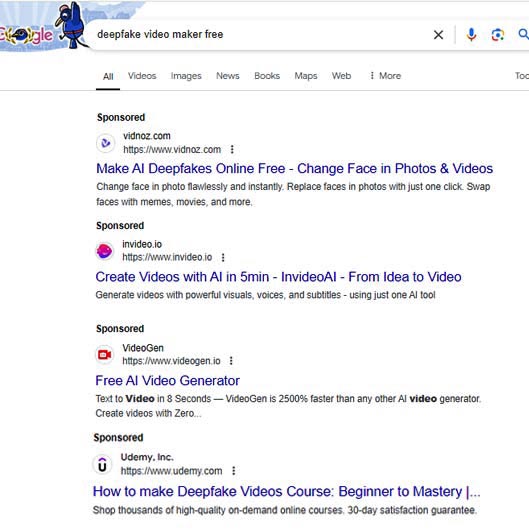Deepfake Videos – could you spot one?
Tuesday, August 13th, 2024
The Forum emphasises that prevention, understanding threats and appropriate actions, is by far the best approach to keep ourselves safer from frauds and scams. Nowhere is this more true than in the case of ‘deepfake’ videos. Not only because of their ever growing prevalence, but some of the platforms on which they most frequently appear to be beyond the reach of regulators – especially X/Twitter and TikTok.
Deepfake: A video, that has been digitally manipulated to replace one person’s likeness convincingly with that of another, often used maliciously to show someone doing something that he or she did not do.
Oxford English Dictionary
Deepfakes are easy to create
The tools to create deepfake videos are very easy to obtain. Here are the top results from a search on Google:

How deepfake videos may be used
Small wonder, therefore, that such videos are proliferating as a favoured method of scammers. Fraudsters use deepfake videos in many ways – to steal identities, impersonate people you know and pose as famous people to sell dodgy products and investments.
In its 2024 identity fraud report, identity verification company Onfido found a 3,000% increase in the use of deepfake attempts at identity fraud in 2023 compared to 2022. Onfido cited growth in the accessibility of cheap online tools, apps and generative AI.
Verification and authentication company iProov also reported an increase in the use of deepfakes in the form of face-swap technology, which is software that allows you to put someone else’s face over your own in a video. It saw these types of attacks grow by over 700% in the second half of 2023, when compared to the first half of the year.
Have a look at the following video – would you identify that it is NOT Morgan Freeman?
Closer to home, here’s an interview with Martin Lewis on ITV’s Good Morning Britain in July 2023:
How aware are the public? Not enough.
Though deepfakes are becoming ever more prevalent, knowledge of the existence of deepfake videos is far from universal.
Research from Santander shows more than half of Britons – 53 per cent – have either not heard of the term deepfake or misunderstood what it meant, with only 17 per cent of consumers confident they could easily identify a deepfake video.
“Generative AI is developing at breakneck speed, and we know it’s ‘when’ rather than ‘if’ we start to see an influx of scams with deepfakes lurking behind them,” said Santander’s head of fraud risk management Chris Ainsley, who features in the deepfake videos. “We already know fraudsters flood social media with fake investment opportunities and bogus love interests, and unfortunately, it’s highly likely that deepfakes will begin to be used to create even more convincing scams of these types.”
Santander’s research states that 36 per cent of Britons have already knowingly watched a deepfake. 28 per cent of respondents reported having seen a deepfake on Facebook, followed by 26 per cent on X (formerly Twitter), 23 per cent on TikTok, and 22 per cent on Instagram.
Spotting and reporting a deepfake video
Many deepfake videos are already hard to identify, and the technology will only get better. But here are some pointers:
- Watch out for low quality lip-syncing.
- Pay attention to details and quality – do the hair, lighting and skin tone of the person look believable? Is there any blurring in the video?
- Listen out for strange background noises or robotic voices.
- Look for unnatural facial expressions.
- Check where the video comes from. If it wasn’t posted by an official account, you should be suspicious of it.
Did you know? You can report scam videos on social media: look for the 3 dots, select and then click ‘Report’.

Sources: Thames Valley Alerts, Trading Standards, National Technology News, Santander, moneysavingexpert.com
Other Recent Posts
Anyone can fall for an AI voice clone
Thursday, September 19th, 2024
Using voice cloning technology, scammers replicate voices, which can be used to dupe a person into sending money. James Nesbitt and Starling Bank have joined forces to promote the ‘Safe Phrases’ campaign. Watch the video. Read More...
Are you ‘oversharing’ on Social Media?
Tuesday, August 6th, 2024
Do your social media posts give away too much to potential fraudsters? A though provoking video, and a leaflet from getsafeonline.org providing tips and advice on guarding against oversharing online. Read More...
New Police and Crime Plan 2024-2029
Tuesday, August 6th, 2024
Thames Valley Police and Crime Commissioner Matthew Barber has published his Police and Crime Plan 2024-2029. This is grouped aroud three main themes – ‘Protecting Communities’, ‘Protecting People’ and ‘Protecting Property’. Read More...
Free webinar – Staying safe from scams, artificial intelligence (AI) fraud & cybercrime
Saturday, July 13th, 2024
Free webinar, for advice on how to spot a scam, how to report one and the ways you can protect yourself and others against them. Tuesday 16th July 2024 10:00am – 11:30am, via Microsoft Teams. Read More...
How we can help tackle industrial-scale Fly Tipping
Thursday, July 4th, 2024
Illegal waste activity is a massive cost to the economy and environment, often perpetrated by organised criminals. TVP, the Environment Agency and Buckinghamshire Council has had some significant successes recently. Read More...
Avoiding Courier Fraud
Wednesday, May 29th, 2024
Courier Fraud targets in particularly elderly and vulnerable victims. What are the signs when receiving a cold call, and what should we do? Read More...








